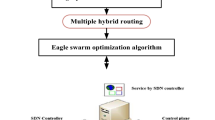Abstract
The number of internet-of-thing (IoT) devices has recently been growing at a rapid rate. From the fact that most of IoT devices are connected through advanced wireless technologies, their coexistence issues become important. Distributed and densely-deployed nature of IoT networks render wireless scheduling very challenging. This work develops a distributed scheduling strategy for a network of wireless IoT devices. To be precise, it aims at maximizing the overall sum rate of the wireless network where a centralized coordination is not supported. The proposed approach considers a synchronized slotted structure consisting of two phases: distributed scheduling and distributed communication phase. In the distributed scheduling phase, IoT devices, via reciprocal exchange of simple messages, share local information with neighboring devices and decide scheduling policies. In the distributed communication phase, the devices communicate with their neighbors on scheduled slots. To this end, a state-of-the-art message-passing framework is introduced to develop a distributed scheduling algorithm. Based on the notion of a factor graph, the developed distributed scheduling algorithm finds an efficient scheduling solution that maximizes the overall sum rate of the network. Simulation results verify that the developed algorithm outperforms existing distributed techniques to a considerable extent in a consistent fashion.











Similar content being viewed by others
References
Xu LD, He W, Li S (2014) Internet of things in industries: A survey. IEEE Trans Indust Inform 10 (4):2233–2243
van Kranenburg R, Anzelmo E, Bassi A, Caprio D, Dodson S, Ratto M (2011) The internet of things. In: Proceedings 1st Berlin Symp. Internet Soc., Berlin, Germany, pp 25–27
Jia X, Feng O, Fan T, Lei Q (2012) RFID technology and its applications in internet of things (IoT). In: Proceedings 2nd IEEE Int. Conf. Consum.electron., Commun. Netw. (CECNet), Yichang, China, pp 1282–1285
Sun C (2012) Application of RFID technology for logistics on internet of things. AASRI Procedia 1:106–111
Li S, Xu L, Wang X (2013) Compressed sensing signal and data acquisition in wireless sensor networks and internet of things. IEEE Trans Ind Informat 9(4):2177–186
Hatler M, Gurganious D, Chi C (2014) Industrial Wireless Sensor Networks A Market Dynamics Report (5th edition), On World, San Diego, CA USA 4Q
Evans D (2011) The internet of things how the next evolution of the internet is changing everything. Cisco White Paper:1–11
Yun S-Y, Yi Y, Shin J, Eun DY (2012) Optimal CSMA: A survey. In: Proceedings IEEE ICCS 2012, pp 199–204
Galinina O, Pyattaev A, Andreev S, Dohler M, Koucheryavy Y (2015) 5G multi-RAT LTE-wifi ultra-dense small cells: Performance dynamics, architecture, and trends. IEEE J Sel Areas Commun 33(6):1224–1240
Zhang R, Wang M, Cai LX, Zheng Z, Shen X (2015) LTE-Unlicensed: the future of spectrum aggregation for cellular networks. IEEE Wirel Commun 22(3):150–159
HART Communication Foundation WirelessHart Technology. Available online: http://www.hartcomm.org/protocol/wihart/wireless_technology.html
International Society of Automation ISA100, Wireless Systems for Automation. Available online: http://www.isa.org/isa100
IEEE Std 802.15.4-2006 (2006) Wireless Medium Access Control (MAC) And Physical Layer (PHY) Specifications for Low-Rate Wireless Personal Area Networks (WPANs); IEEE Computer Society: New York, NY USA
Rodenas-Herraiz D, Garcia-Sanchez A, Garcia-Sanchez F, Garcia-Haro J (2013) Current trends in wireless mesh sensor networks: a review of competing approaches. Sensors 13:5958–5995
Tinka A, Watteyne T, Pister KSJ, Bayen AM (2011) A decentralized scheduling algorithm for time synchronized channel hopping. ICST Trans Mob Commun Appl 11(7–9):1–13
Kschischang FR, Frey BJ, Loeliger H-A (2001) Factor graphs and the sum-product algorithm. IEEE Trans Inform Theory 47(2):498–519
Frey BJ, Dueck D (2007) Clustering by passing messages between data points. Science 315:972–976
Sohn I, Lee SH, Andrews JG (2010) A graphical model approach to downlink cooperative MIMO systems. In: Proceedings IEEE Global Communications Conference (GLOBECOM) 2010
Sohn I, Lee SH, Andrews JG (2011) Belief propagation for distributed downlink beamforming in cooperative MIMO cellular networks. IEEE Trans Wireless Commun 10(12):4140–4149
Shamaiah M, Lee SH, Vishwanath S, Vikalo H (2012) Distributed algorithms for spectrum access in cognitive radio relay networks. IEEE J Sel Areas Commun 30(10):1947–1957
Lee SH, Shamaiah M, Vikalo H, Vishwanath S (2013) Message-passing algorithms for coordinated spectrum sensing in cognitive radio networks. IEEE Commun Lett 17(4):812–815
Lee SH, Sohn I (Aug. 2015) Affinity propagation for energy-efficient BS operations in green cellular networks. IEEE Trans. Wirel. Commun., vol. 8:14
Sohn I (2015) Distributed power control by message-passing for very large-scale networks. Int J Distr Sensor Netw 2015(902838):12
Lee SH, Sohn I (2015) Message-passing-based dynamic point selection for coordinated multipoint transmission. IEEE Commun Lett 19(10):1850–1853
Sohn I, Lee J-H, Lee SH (2016) Low-energy adaptive clustering hierarchy using affinity propagation for wireless sensor networks. IEEE Commun Lett 20(3):558–561
Rappaport TS (2004) Wireless communications. Principles and practive, Prentice Hall
Acknowledgments
This work was supported in part by the National Research Foundation of Korea (NRF) funded by the Korea Government (MSIP) (No. NRF-2015R1C1A1A01052529) and in part by the Basic Science Research Program through NRF funded by the Ministry of Education (No. NRF-2015R1D1A1A01057100).
Author information
Authors and Affiliations
Corresponding author
Additional information
This paper was partly presented in International Conference on ICT Convergence (ICTC 2015)
Rights and permissions
About this article
Cite this article
Sohn, I., Yoon, S.W. & Lee, S.H. Distributed scheduling using belief propagation for internet-of-things (IoT) networks. Peer-to-Peer Netw. Appl. 11, 152–161 (2018). https://doi.org/10.1007/s12083-016-0516-6
Received:
Accepted:
Published:
Issue Date:
DOI: https://doi.org/10.1007/s12083-016-0516-6




